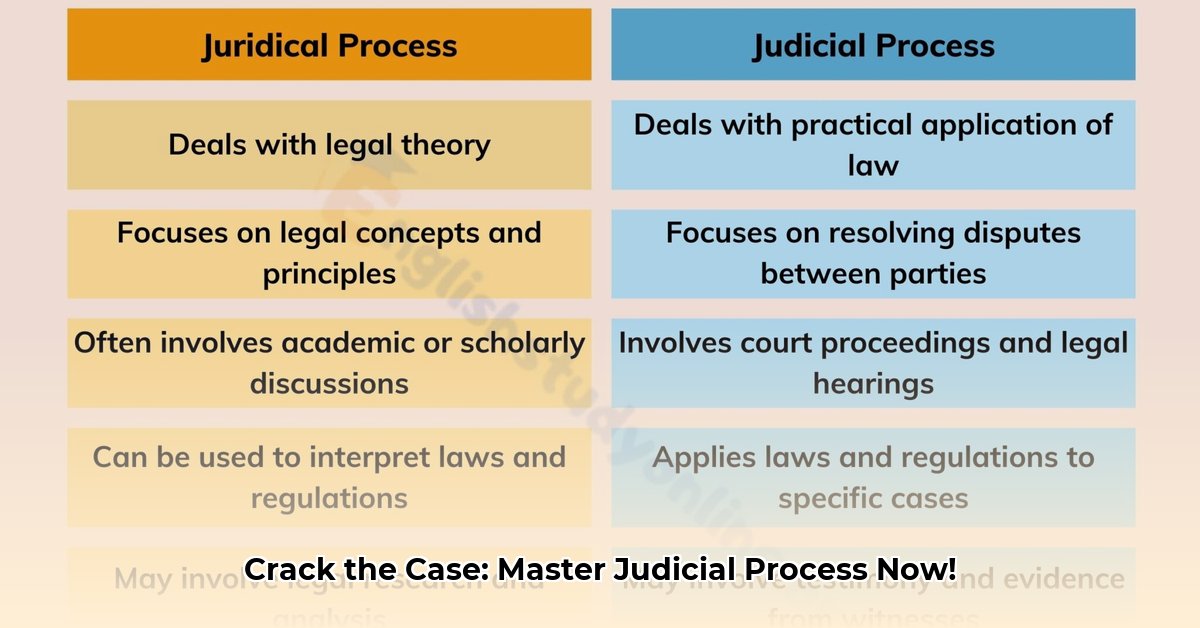# Navigating the Judicial Process: An Expert Guide to Law, Policymaking, and Case Analysis
Do you find yourself struggling to understand how courts make decisions and shape our laws? This comprehensive guide will unlock the mysteries of the judicial process, from understanding legal concepts like precedent and judicial review to analyzing landmark court cases and their societal impact. Whether you're a student, policymaker, or simply a curious citizen, this guide provides the tools to navigate judicial policymaking and become an informed participant in democracy. Get ready to explore the depths of the judicial system and become a judicial process expert!
## Understanding the Judicial Process: An Expert Guide to Case Law and Legal Interpretation
Let's delve into the world of judicial decision-making and legal interpretation. It's more than just reading laws; it's about understanding how judges interpret them, shape their application, and establish precedents that impact our lives. Judges act as legal architects, constantly refining the justice system's framework.
### Key Concepts: Foundations of Judicial Policy and Legal Frameworks
Before we dive in, let's establish the groundwork. What is judicial policymaking? It's the process where judges, through interpreting laws, effectively *make* policy. Their decisions significantly impact society, reshaping the legal landscape.
*Stare decisis*, the principle of respecting prior rulings, is a cornerstone. It provides stability and predictability in the law. However, clashes between precedents can lead to debates. The weight given to past rulings isn't always straightforward.
Judicial review gives courts the power to overturn laws conflicting with the Constitution, acting as a check on legislative and executive power. This deeply affects the legal and political landscapes, making it a powerful and debated tool.
Federalism adds complexity with the interplay between federal and state courts influencing policy outcomes.
Finally, there's the debate on judicial objectivity. Are judges truly impartial, or do personal beliefs influence decisions? Some see complete neutrality as unattainable, while others believe judicial impartiality is essential for a fair legal system. Ongoing research explores potential bias in judicial rulings, revealing evolving conclusions and fueling debate. How does judicial impartiality affect the legal system's perceived fairness?
### Analyzing Judicial Decisions: A Step-by-Step Guide to Unlocking Case Studies
Let's get practical with case law analysis. Analyzing a court decision is like detective work, piecing together clues to solve a complex puzzle. Here's a step-by-step process:
**Step 1: Setting the Stage – The Facts.** What happened? Who were the parties involved? What claims were made? These facts form the case's foundation.
**Step 2: Identifying the Core Issue.** What specific legal question is the court addressing? This is crucial—the central question the court needs to answer.
**Step 3: Deconstructing the Reasoning.** How does the court reach its decision? They cite precedents, legal principles, and societal considerations. Understanding their reasoning is key.
**Step 4: Determining the Holding.** What's the court's final ruling? This is the answer to the central question—the court's conclusion.
**Step 5: Envisioning the Future – The Implications.** How will this decision influence future cases or public policy? This involves predicting the court's decision's ripple effect and understanding its long-term consequences.
Consider *Miranda v. Arizona*, where the Supreme Court ruled that criminal suspects must be informed of their constitutional rights before interrogation. This landmark case illustrates how judicial decisions establish precedents that protect individual liberties and shape law enforcement procedures.
### Policy Implications: Bridging the Gap from Courtroom to Community
Understanding judicial policymaking isn't just for legal professionals; it affects everyone. Legislators can anticipate court reactions to new laws, policymakers can predict judicial decisions' impacts on initiatives, and citizens can understand court rulings and engage meaningfully in the legal system. It’s about informed action and shaping goals.
Here's how different groups are affected:
| Stakeholder Group | Short-Term Impact | Long-Term Impact |
| ------------------------- | -------------------------------------------------------------------------- | -------------------------------------------------------------------------------- |
| Legislators | Adjust laws based on probable court reactions. | Develop strategies for influencing judicial interpretation. |
| Policymakers | Incorporate expected judicial outcomes into strategies. | Adapt and refine policies based on case law developments. |
| Citizens | Advocate for change informed by judicial interpretations. | Engage in civic action based on a clear understanding of the legal system. |
| Legal Professionals | Utilize precedents in case law to advocate for clients effectively. | Shape legal arguments and strategies based on evolving judicial interpretations. |
| Businesses | Adapt business practices to comply with court rulings on regulatory matters. | Anticipate legal challenges and mitigate risks based on legal precedents. |
### Test Your Understanding: Judicial Process Study Questions for Law Students and Engaged Citizens
Put your knowledge to the test with these questions in different formats.
**Multiple Choice:**
1. *Judicial Review*: a) is the power of the executive branch; b) means following the Constitution; c) involves changing prior rulings; d) defines the role of state courts.
**Short Answer:**
1. How does the principle of *stare decisis* promote stability and predictability in the legal system?
**Essay Question:**
1. Discuss the role of judicial activism versus judicial restraint in shaping constitutional law. Support your arguments with examples.
**Case Study Challenge:** Choose a significant Supreme Court case (e.g., *Citizens United v. FEC*, *Obergefell v. Hodges*). Analyze the facts, central issue, court's reasoning, decision, and societal impacts.
By actively engaging with these questions, you'll deepen your understanding of the judicial process. Studying this isn't just about learning legal theories; it's about understanding how law shapes and reflects our society's values. It's a dynamic system that affects us all.
## Predicting Supreme Court Decisions: Jurisprudential Trends and Legal Analysis in Practice
### The Science of Prediction: Supreme Court Decisions and Analytical Trends
Predicting Supreme Court decisions is complex but can exceed random chance accuracy, indicating the influence of legal patterns. However, it presents challenges.
Machine learning models using case characteristics (issue area, prior rulings, justice ideology) offer promise.
Generalizability across time and different court compositions is a hurdle.
Predicting solely on pre-decision information is crucial yet difficult.
Ethical concerns about bias and misuse of predictive models are paramount.
### Understanding the Supreme Court's Landscape
Before predicting Supreme Court decisions based on jurisprudential trends, understand these foundational concepts. *Stare decisis* influences rulings. Judicial review shapes the Court's role. Federalism impacts case outcomes. And judicial objectivity requires consideration. These elements influence Supreme Court decisions. How do changing social norms influence the Supreme Court's interpretation of laws?
### Interpreting Precedent: A Guide for Legal Professionals
Analyzing Supreme Court case law to identify trends is a systematic process.
1. **Identify the Issue:** What legal question is before the Court?
2. **Analyze the Reasoning:** How does the majority opinion justify its decision? What precedents are invoked? What are the dissenting arguments?
3. **Contextualize the Decision:** What is the historical context? Consider societal shifts, political climates, and legal interpretations.
4. **Spot the Trends:** Are there patterns in similar cases? Are there shifts in ideology? Which factors influence outcomes?
5. **Predict Future Outcomes:** Based on trends and case context, hypothesize likely Supreme Court rulings. This is probabilistic, not deterministic.
### Predictive Modeling: Promises and Pitfalls in Legal Systems
Machine learning offers possibilities for predicting Supreme Court decisions. Models using case characteristics often show above-chance accuracy. If a case type consistently gets a specific outcome, a model can learn that pattern. However, these models aren't perfect and struggle with generalizability. The political and social landscape reshapes the judicial landscape.
### Ethical Considerations: Algorithms, Transparency, and Algorithmic Bias
Predictive models raise ethical concerns. Bias within training data can skew outcomes, and the "black box" nature of algorithms can limit transparency. We must ensure fairness and use these tools responsibly. How can we ensure impartiality when using AI to predict judicial decisions?
Latest posts by Lola Sofia (see all)
















